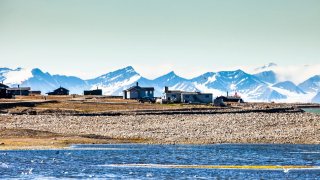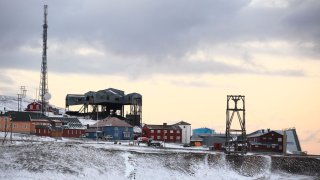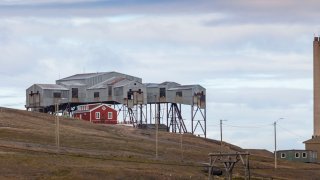Statistikk innhold
Statistics on
Industry statistics for Svalbard
The statistics provide insight into the development and structure of the various industries in Svalbard. The figures include man-years, employment, turnover, costs and investment, based on reported data from all active businesses located in Svalbard.
Selected figures from these statistics
- Svalbard. Industry statistics, by main industry (SIC2007)Download table as ...Svalbard. Industry statistics, by main industry (SIC2007)
Man-years Turnover (NOK 1 000) 2024 Percentage change from last year 2024 Percentage change from last year Svalbard total 1 668.4 -2.2 5 519 112 1.2 Mining and quarrying 70.0 -7.9 187 612 57.9 Manufacturing; Electricity, gas, steam and air conditioning supply; Water supply; sewerage, waste management and remediation activities 51.6 -13.3 232 427 15.8 Construction 133.6 -36.1 603 147 -16.6 Wholesale and retail trade 129.7 4.0 659 994 32.8 Transportation and storage 148.6 14.0 1 014 331 -13.8 Accommodation and food service activities 309.0 4.6 566 806 11.0 Information, communication, financial and insurance activities 81.9 4.2 984 169 -5.2 Real estate activities 2.6 -10.3 162 070 10.6 Professional, scientific and technical activities 61.6 -17.5 117 176 23.0 Administrative and support service activities 221.0 20.1 664 121 9.8 Public administration and defence 107.4 3.2 47 949 -27.9 Education 171.1 -6.7 : : Human health and social work activities 62.8 1.8 13 527 : Arts, entertainment and recreation 102.3 -6.6 167 011 3.0 Other service activities 13.5 21.6 14 822 1.3 Explanation of symbolsDownload table as ... - Local KAUs on Svalbard. Main figures by code system and structure.Download table as ...Local KAUs on Svalbard. Main figures by code system and structure.
Establishments Man-years Turnover (NOK 1 000) Public Subsidies (NOK 1 000) Wage costs (NOK 1 000) Investments (NOK 1 000) 2023 2024 2023 2024 2023 2024 2023 2024 2023 2024 2023 2024 Svalbard total 387 395 1 705.2 1 668.4 5 456 184 5 519 112 940 393 1 069 514 1 373 194 1 433 049 778 348 718 843 B Mining and quarrying 1 1 76.0 70.0 118 798 187 612 - - 84 503 91 629 3 090 75 C+D+E Manufacturing; Electricity, gas, steam and air conditioning supply; Water supply; sewerage, waste management and remediation activities 21 22 59.5 51.6 200 752 232 427 : : 53 175 49 292 77 916 : F Construction 22 19 209.0 133.6 722 914 603 147 - - 162 062 121 150 20 016 : G Wholesale and retail trade, repair of motor vehicles and motorcycles 32 34 124.7 129.7 497 082 659 994 - - 75 563 82 635 36 526 18 979 H Transportation and storage 24 21 130.4 148.6 1 176 635 1 014 331 - - 152 531 184 972 50 230 54 466 I Accommodation and food service activities 25 24 295.5 309.0 510 514 566 806 : : 165 068 193 706 15 221 61 584 J+K Information and communication. Financial and insurance activities 17 14 78.6 81.9 1 038 592 984 169 : : 80 074 84 098 : : L Real estate activities 37 43 2.9 2.6 146 595 162 070 : : 2 605 1 903 111 958 118 791 M Professional, scientific and technical activities 66 62 74.7 61.6 95 293 117 176 74 918 104 333 65 455 67 127 4 767 37 027 N Administrative and support service activities 61 61 184.0 221.0 604 682 664 121 57 773 59 183 129 685 149 949 148 760 198 920 O Public administration and defence; compulsory social security 10 9 104.1 107.4 66 486 47 949 375 466 389 907 113 489 106 330 18 406 35 330 P Education 15 14 183.4 171.1 : : 239 208 250 041 159 947 159 051 10 023 : Q Human health and social work activities 11 11 61.7 62.8 : 13 527 26 598 29 852 56 561 59 816 : 1 293 R Arts, entertainment and recreation 37 38 109.5 102.3 162 218 167 011 30 816 29 477 64 358 71 571 33 501 16 251 S Other service activities 8 10 11.1 13.5 14 629 14 822 : : 8 118 9 325 0 : Missing 0 : 0.0 : 0 : 0 - 0 : 0 : Explanation of symbolsDownload table as ...
About the statistics
The information under «About the statistics» was last updated 5 July 2023.
Establishment
The Standard Industrial Classification (SN07) defines an establishment as a locally defined functional unit whose main activities fall within a specific industrial classification. The activity carried out by a legal entity (enterprise) is known as an establishment. A legal entity can engage in one or more establishments/businesses.
Number of man-hours worked
This is defined as the total number of hours worked by employees in a workplace, both within and outside normal working hours. Short breaks are included, but time spent in transit between home and the workplace is not included. Number of man-hours in a year is 1687 hours
Hours worked by seasonal workers counts as long as worker is employed directly by establisment, it means not by employment tempt agency.
Employment
Employment is defined as the total number of owners and employees. One person is only counted in his/her main job, the same person here can have more than one job.
Turnover
Turnover is defined as an enterprise's operating revenues minus government subsidies and gains on the sale of fixed assets. Special public duties related to the sale, and taxes and duties are included in the turnover, but VAT is not included.
Salary costs
Wages, holiday pay, fees, employer's national insurance contributions, pension costs subject to reporting and other personnel costs for work carried out on Svalbard. Salary costs do not include remuneration to owners of sole proprietorships or partnerships.
Public subsidies
Applies to allocations received for operations and investment from the government, the local government on Longyearbyen, and other public bodies (e.g. Innovation Norway). It is rapported separetly in its own field. It is not included in turnover.
Merchandise
Is defined as goods purchased during the year and and sold without further processing (with the exception of labeling and packaging).
Total purchase of goods and services
The total purchase of goods and services includes the value of all goods and services that are purchased during the course of the year for resale, for use in the enterprise’s own production process or for storage. The procurement of tangible fixed assets is not included in these figures.
Investments
Investments in assets with a lifetime of more than a year, including investments in new and used capital goods, and extensions, alterations, improvements and repairs that prolong the lifetime of the capital goods or increase their production capacity. Costs for design, transportation, installation and any special duties are also included.
Deductible VAT, financial expenses, tax benefits achieved (e.g. investments in more environmentally-friendly equipment) and fixed assets acquired through restructuring (e.g. mergers, takeovers, demergers, divisions) are not included.
Purchased goods are valued at cost price and self-produced goods are valued at production cost.
Public sector
The public sector can be divided into an public administration part and an public enterprise part. The public administration consists of the authorities and other companies that take care of a wide range of society's common tasks. Hospitals and schools are examples of institutions that are part of the public administration. The public enterprise part consists of market-based enterprises that are owned or otherwise controlled by the public sector. The public enterprises are companies such as water supply, sewerage, waste management og large companies where state owns more then half of the shares.
The industrial classification is in accordance with the Norwegian Standard Industrial Classification (SN2007) , used in Statistics Norway, which is based on the EU Standard NACE Rev. 2 and the United Nation’s International Standard Industrial Classification of all Economic Activities (ISIC), Rev. 4.
Name: Industry statistics for Svalbard.
Topic: Transport and tourism
Division for Structural Business Statistics.
National level.
Annually.
Preliminary key figures are published eight months after the end of the statistics year. Final figures are released together with final figures for the other structure statistics within 20 months of the year to which the figures apply.
Not relevant.
Collected and revised data are stored securely by Statistics Norway in compliance with applicable legislation on data processing.
Statistics Norway can grant access to the source data (de-identified or anonymised microdata) on which the statistics are based, for researchers and public authorities for the purposes of preparing statistical results and analyses. Access can be granted upon application and subject to conditions. Refer to the details about this at Access to data from Statistics Norway.
The industry statistics for Svalbard are a full census at establishment level. The statistics are published on an ongoing basis and provide detailed information on the activity on Svalbard based on data collected from all active establishments.
The statistics are intended to show the structure within all the main sectors of industry in the Standard Industrial Classification based on data collected from the relevant financial year. The statistics were first published in the statistics year 2008.
The data is useful for central and local authorities, ministries and various trade associations that require statistics on Svalbard. The figures that are collected are made unidentifiable and the micro data is accessible to researchers in accordance with standard terms of Statistics Norway. Coordinated data collection entails Statistics Norway being responsible for collecting data from the establishments on Svalbard and the data required for Svalbard: Society and industrial affairs being covered in the data basis. The timeliness in relation to Longyearbyen's local government previous data releases is maintained and released at an earlier date than other national industry statistics.
No external users have access to statistics until it is published for everyone at 08.00 on ssb.no after prior notice no later than three months before in the Statistikkalenderen. This is one of the most important principles in Statistics Norway to ensure equal treatment of users.
While the industry statistics can provide employment figures on a detailed industry and are consistent with other establishment-related variables, the national accounts provide quarterly figures with a short production time. The Labour Market Survey and the register-based employment statistics also provide figures on personal identifiers such as age, sex, education and working hours. The register-based employment statistics also give figures down to municipality level.
The statistics are developed, produced and disseminated pursuant to Act no. 32 of 21 June 2019 relating to official statistics and Statistics Norway (the Statistics Act).
No EU legislation.
The Industry survey for Svalbard is broken down in line with the Standard Industrial Classification SIC2007 and covers the following industries:
| 05-09 | - | Mining and quarrying | |||||||||||||||||||||||||||||||||||||
| 10-33 | - | Manufacturing | |||||||||||||||||||||||||||||||||||||
| 35 | - | Electricity, gas, steam and air conditioning supply | |||||||||||||||||||||||||||||||||||||
| 36-39 | - | Water supply; sewerage, waste management and remediation activities | |||||||||||||||||||||||||||||||||||||
| 41-43 | - | Construction | |||||||||||||||||||||||||||||||||||||
| 45-47 | - | Wholesale and retail trade; repair of motor vehicles and motorcycles | |||||||||||||||||||||||||||||||||||||
| 49-53 | - | Transportation and storage | |||||||||||||||||||||||||||||||||||||
| 55-56 | - | Accommodation and food service activities | |||||||||||||||||||||||||||||||||||||
| 58-63 | - | Information and communication | |||||||||||||||||||||||||||||||||||||
| 64-66 | - | Financial and insurance activities | |||||||||||||||||||||||||||||||||||||
| 68 | - | Real estate activities | |||||||||||||||||||||||||||||||||||||
| 69-75 | - | Professional, scientific and technical activities | |||||||||||||||||||||||||||||||||||||
| 77-82 | - | Administrative and support service activities | |||||||||||||||||||||||||||||||||||||
| 84 | - | Public administration and defence; compulsory social security | |||||||||||||||||||||||||||||||||||||
| 85 | - | Education | |||||||||||||||||||||||||||||||||||||
| 86-88 | - | Human health and social work activities | |||||||||||||||||||||||||||||||||||||
| 90-93 | - | Arts, entertainment and recreation | |||||||||||||||||||||||||||||||||||||
| 94-96 | - | Other service activities | |||||||||||||||||||||||||||||||||||||
All of the establishments within these industries are included in the statistics if they are registered as an active business on Svalbard in the statistics year.
Primary industries farm, forestry and fishing (01 - 03: SN2007) are not covered in the industry statistics for Svalbard. For details about the capture volume and value in the waters off Svalbard, please visit the ministry's side: https://www.fiskeridir.no/English . More details of these variables for fisheries protection zone around Svalbard and other nearby hunting zones can be found here.
For an establishment, the statistics are based on the Business Statement (NO) or annual accounts. The business statement is reported electronically via the Norwegian Directorate of Taxes.
The data is quality assured using the following sources:
- Electronically delivered tax statements to the Tax Directorate
- Register of Company Accounts at Brønnøysund
The Central Register of Establishments and Enterprises is used when collecting data. The register is updated regularly with data relating to Svalbard in collaboration with the local government on Longyearbyen, the Central Coordinating Register for Legal Entities, various trade organisations and directly from the individual establishment/enterprise.
The population consists of all active establishments within the aforementioned industry sectors in the statistics year.
Data Collection
The forms will be sent out in April / May, and have a 4-week response deadline.
Establishments that do not answer by the deadline are sent a written reminder about 10 days after expiry of the deadline. Establishments that do not respond after receiving the reminder are issued with a compulsory fine.
Editing
Controls and alignments are carried out on data received from establishments, tax statements and annual accounts. Revisions of the data are carried out after controls against figures from the previous year, the Central Register of Establishments and Enterprises, Register of Company Accounts at Brønnøysund, other available sources and according to consultations with the respondent where necessary.
Data received is controlled against electronically delivered tax statements, annual accounts and through contact with the respondent. Since the statistics are a full census, there is no need for estimations.
The employment figures are controlled against the Register of employees and employers, and undergo a manual or automated revision prior to publishing, based on the control source.
Last year's numbers are edited when final figures arepublished, sice the static data releases earlier than other national statistics.
Estimation
All enterprises are included in the population. Calculations of figures are based on reported numbers. Figures are constructed based on income statements (NO) or anual reports for those companies that have not participated.
Not relevant.
Due to the situation of domineering establishments on Svalbard, exemption from confidentiality is required for Store Norske Spitsbergen Kullkompani AS. Otherwise, the rule is applied which stipulates that figures are not published where there are fewer than three units in a cell in a table. The reason for this is a risk of identification whereby the figures can be traced back to the respondent. This particularly applies when publishing figures at a low geographical level. This is solved by suppressing these figures in the table.
To ensure confidentiality, the ‘[suppression]1’ method is used in these statistics.
Employees of Statistics Norway have a duty of confidentiality.
Statistics Norway can make exceptions to the general rule if deemed necessary to meet the requirements of the EEA agreement, if the respondent is a public authority, if the respondent has consented to this, or when the information disclosed is openly accessible to the public.
More information can be found on Statistics Norway’s website under Methods in official statistics, in the ‘Confidentiality’ section.
When comparing with previously published figures, users should be aware that older data may have been corrected in connection with the revision of the statistics for the last year. In addition, updating of industry codes in the Central Register of Establishments and Enterprises could lead to changes for some of the industries. Such changes will not be reflected in the figures for previous years.
Accuracy and reliability
Measurement errors arise when the respondent gives the wrong answer due to an oversight, misunderstanding or similar.
Processing errors are possible but we have a complex control system to avoid them.
Form-based surveys normally contain a certain number of non-responses. Non-responses by units are due to circumstances such as closure, bankruptcy, mergers, demergers, holidays, errors in the dispatch, refusals and similar. Partial non-responses (where answers are missing to individual questions) can be due to oversights, lack of data or other circumstances.
The variables that are included are based on a full census. Sampling errors are therefore not relevant.
Several administrative registers are central to the work entailed in the structure statistics. The Central Register of Establishments and Enterprises is used both to define the population and to retrieve identifiers and data. The Central Coordinating Register for Legal Entities at Brønnøysund are used to retrieve data on the units. These data form the basis for two types of register errors, which can have an impact on the uncertainty in the statistics.
The most common error is as a result of time lags in the registers. Such time lags can be caused by late reporting to the registers or because changes are normally registered some time after they have occurred. The consequences are that the registers are not fully up-to-date at any given time, which can lead to imbalances in the sampling or outdated data being used in the statistics.
A revision is a planned change to figures that have already been published, for example when releasing final figures as a follow-up to published preliminary figures. See also Statistics Norway’s principles for revisions.



